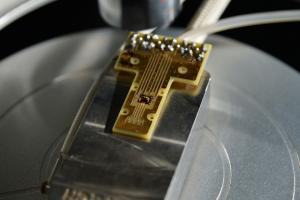Discovering the magnetic properties of van der Waals magnetic bodies
Exchange bias characteristic 10 times
Expected to improve the performance of spin semiconductors
![The appearance of a spin device using van der Waals magnetic material developed by the KIST PhD team.[사진=KIST]](https://i0.wp.com/news.google.com/news/photo/202104/81604_32747_3254.jpg?w=560&ssl=1)
A research result that shows that the information storage stability of Van der Waals magnetic material, which is attracting attention as a material candidate for spin memory by domestic researchers, is more than 10 times higher than that of other materials is drawing my attention.
Semiconductor companies and research institutes around the world feel the limit in improving the efficiency of silicon semiconductors being mass-produced, and are paying attention to spin memories that can overcome them.
Research on the working principle of spin memory has made considerable progress, and in recent years, efforts to find suitable materials are in full swing.
The Korea Advanced Institute of Science and Technology (KIST) research team led by Dr. Joon-Woo Choi of the Spin Convergence Research Center found that the’exchange bias’ characteristic, which indicates the stability of the van der Waals magnetic material to store information, is more than 10 times larger than that of a general magnetic material, and has fundamentally different physical properties. I said I did.
Van der Waals magnetic material is a magnetic material composed of’van der Waals’ bonds that have weak bonding strength between layers of a material.Unlike ordinary materials having a three-dimensional structure, the bonding force between layers is weak and thus a single atomic layer It is also called a two-dimensional material because it can be easily separated with a flat surface.
In 2017, new materials exhibiting ferromagnetic properties, which are characteristics of maintaining external magnetism, were discovered among van der Waals materials, and research on next-generation spin semiconductors that stores the spin direction of the magnetic as information is actively progressing using them.
However, despite active research, Van der Waals magnetic materials were not found to have noticeably different magnetic properties other than the structural properties of being separated by atomic layer units compared to conventional magnetic materials such as iron and cobalt.
As a result of analyzing the characteristics of’Fe3GeTe2′, a representative Van der Waals magnetic material, the research team of Dr. Joon-Woo Choi has hardly been affected by the thickness, unlike conventional magnetic materials, where the size of the exchange bias weakens as the thickness increases, and the size of the exchange bias ( Data storage stability) can be more than 10 times larger.
In addition, it was revealed that these peculiar magnetic properties were due to weak interlayer interactions, an inherent property of van der Waals materials.
Exchange bias is a key operating principle of the next-generation spin memory, which has been mass-produced since 2018, and plays a crucial role in the stable storage of spin information. Therefore, the result of this study suggests that the information storage stability of the next-generation spin memory can be greatly improved by utilizing a van der Waals magnetic material with a large exchange bias.
Dr. Joon-Woo Choi of KIST said, “Based on the results of this study, it is expected that new materials for spin semiconductors with excellent performance will be developed by utilizing the junction structure of van der Waals magnetic materials and van der Waals materials of different properties in the future.”
This research was carried out with support from the Ministry of Science, ICT and ICT as support for KIST’s major projects, creative convergence research projects, and leading research center support projects. The research results were published in the latest issue of’Nano Letters’ (IF: 12.279, top 5.743% in JCR), an international journal in the field of nanoscience.
Copyright holder © Information and communication newspaper unauthorized reproduction and redistribution prohibited
